INFINITI Q70 HYBRID 2018 Owner's Manual
Manufacturer: INFINITI, Model Year: 2018, Model line: Q70 HYBRID, Model: INFINITI Q70 HYBRID 2018Pages: 458, PDF Size: 2.23 MB
Page 361 of 458

6-12In case of emergency
NOTE:
If it is not possible to turn the hybrid system
ON by following this procedure, it is
recommended that you contact an INFINITI
retailer immediately.Do not attempt to start the engine by
pushing.
CAUTION
.
Automatic transmission models can-
not be push-started or tow-started.
Attempting to do so may cause
transmission damage.
. Three way catalyst equipped models
should not be started by pushing
since the three way catalyst may be
damaged.
. Never try to start the vehicle by
towing it; when the engine starts,
the forward surge could cause the
vehicle to collide with the tow vehi-
cle.
. Hybrid models cannot be push-
started or tow-started. Attempting
to do so may cause electrical or
transmission damage.
CAUTION
.Do not continue to drive if your
vehicle overheats. Doing so could
cause engine damage or a vehicle fire.
. To avoid the danger of being scalded,
never remove the radiator cap while
the engine is still hot. When the
radiator cap is removed, pressurized
hot water will spurt out, possibly
causing serious injury.
. Do not open the hood if steam is
coming out.
If your vehicle is overheating (indicated by an
extremely high temperature gauge reading),
or if you feel a lack of engine power, detect
abnormal noise, etc., take the following
steps:
1. Move the vehicle safely off the road, apply the parking brake and move the
shift lever to the P (Park) position.
Do not turn the INFINITI Direct Re-
sponse Hybrid
®System off.
2. Turn off the climate control. Open all the windows, move the heater or air condi-
tioner temperature control to maximum
hot and fan control to high speed.
PUSH STARTING IF YOUR VEHICLE OVERHEATS
Page 362 of 458

3. If engine overheating is caused by climb-ing a long hill on a hot day, run the engine
at a fast idle (approximately 1,500 rpm)
until the temperature gauge indication
returns to normal.
4. Get out of the vehicle. Look and listen for steam or coolant escaping from the
radiator before opening the hood. (If
steam or coolant is escaping, turn off the
hybrid system.) Do not open the hood
further until no steam or coolant can be
seen.
5. Open the engine hood.
WARNING
If steam or water is coming from the
engine, stand clear to prevent getting
burned.
6. Also check if the cooling fan is running. The radiator hoses and radiator should
not leak water. If coolant is leaking or the
cooling fan does not run, stop the hybrid
system.
WARNING
Be careful not to allow your hands, hair,
jewelry or clothing to come into contact
with, or get caught in, engine belts or the
engine cooling fan. The engine cooling
fan can start at any time.
7. After the engine cools down, check the coolant level in the reservoir tank with
the engine running. Add coolant to the
reservoir tank if necessary. Have your
vehicle repaired. It is recommended you
visit an INFINITI retailer for this service. When towing your vehicle, all State (Pro-
vincial in Canada) and local regulations for
towing must be followed. Incorrect towing
equipment could damage your vehicle. Tow-
ing instructions are available from an
INFINITI retailer. Local service operators
are familiar with the applicable laws and
procedures for towing. To assure proper
towing and to prevent accidental damage to
your vehicle, INFINITI recommends that you
have a service operator tow your vehicle. It is
advisable to have the service operator care-
fully read the following precautions.
WARNING
.
Never ride in a vehicle that is being
towed.
. Never get under your vehicle after it
has been lifted by a tow truck.
CAUTION
.When towing, make sure that the
transmission, axles, steering system
and powertrain are in working con-
dition. If any unit is damaged, dollies
must be used.
. Always attach safety chains before
In case of emergency6-13
TOWING YOUR VEHICLE
Page 363 of 458
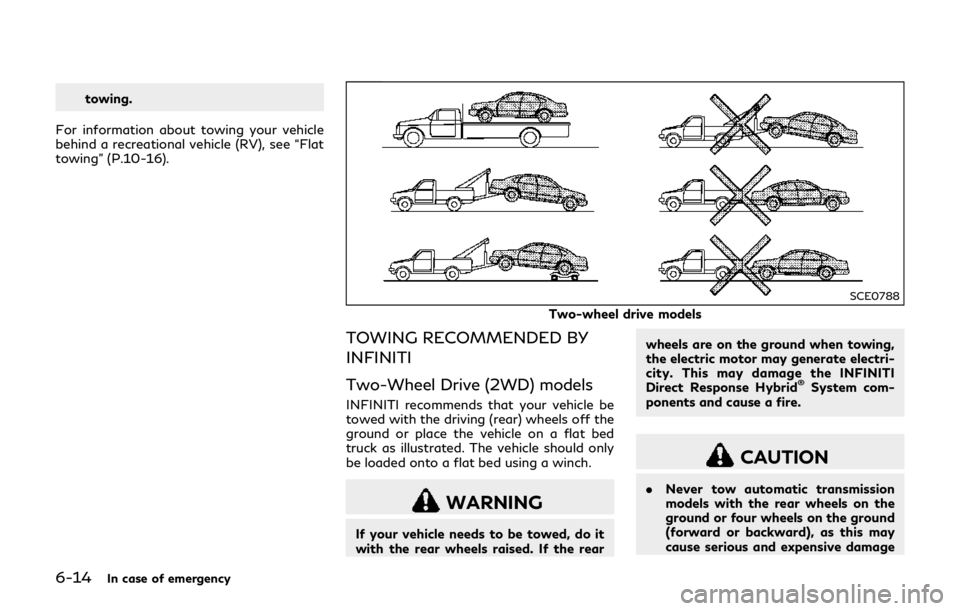
6-14In case of emergency
towing.
For information about towing your vehicle
behind a recreational vehicle (RV), see “Flat
towing” (P.10-16).
SCE0788
Two-wheel drive models
TOWING RECOMMENDED BY
INFINITI
Two-Wheel Drive (2WD) models
INFINITI recommends that your vehicle be
towed with the driving (rear) wheels off the
ground or place the vehicle on a flat bed
truck as illustrated. The vehicle should only
be loaded onto a flat bed using a winch.
WARNING
If your vehicle needs to be towed, do it
with the rear wheels raised. If the rear wheels are on the ground when towing,
the electric motor may generate electri-
city. This may damage the INFINITI
Direct Response Hybrid
®System com-
ponents and cause a fire.
CAUTION
. Never tow automatic transmission
models with the rear wheels on the
ground or four wheels on the ground
(forward or backward), as this may
cause serious and expensive damage
Page 364 of 458
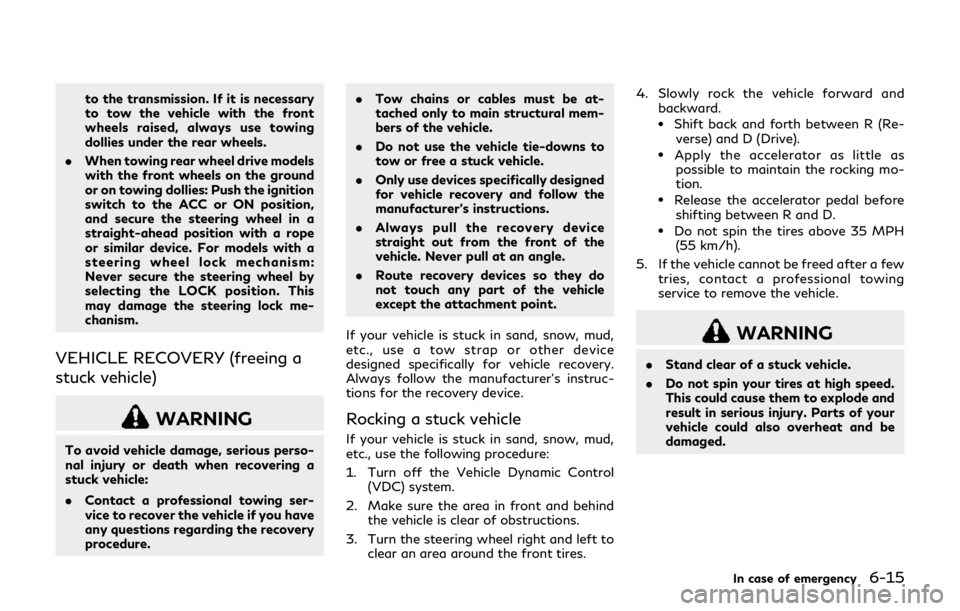
to the transmission. If it is necessary
to tow the vehicle with the front
wheels raised, always use towing
dollies under the rear wheels.
. When towing rear wheel drive models
with the front wheels on the ground
or on towing dollies: Push the ignition
switch to the ACC or ON position,
and secure the steering wheel in a
straight-ahead position with a rope
or similar device. For models with a
steering wheel lock mechanism:
Never secure the steering wheel by
selecting the LOCK position. This
may damage the steering lock me-
chanism.
VEHICLE RECOVERY (freeing a
stuck vehicle)
WARNING
To avoid vehicle damage, serious perso-
nal injury or death when recovering a
stuck vehicle:
.Contact a professional towing ser-
vice to recover the vehicle if you have
any questions regarding the recovery
procedure. .
Tow chains or cables must be at-
tached only to main structural mem-
bers of the vehicle.
. Do not use the vehicle tie-downs to
tow or free a stuck vehicle.
. Only use devices specifically designed
for vehicle recovery and follow the
manufacturer’s instructions.
. Always pull the recovery device
straight out from the front of the
vehicle. Never pull at an angle.
. Route recovery devices so they do
not touch any part of the vehicle
except the attachment point.
If your vehicle is stuck in sand, snow, mud,
etc., use a tow strap or other device
designed specifically for vehicle recovery.
Always follow the manufacturer’s instruc-
tions for the recovery device.
Rocking a stuck vehicle
If your vehicle is stuck in sand, snow, mud,
etc., use the following procedure:
1. Turn off the Vehicle Dynamic Control (VDC) system.
2. Make sure the area in front and behind the vehicle is clear of obstructions.
3. Turn the steering wheel right and left to clear an area around the front tires. 4. Slowly rock the vehicle forward and
backward.
.Shift back and forth between R (Re-verse) and D (Drive).
.Apply the accelerator as little aspossible to maintain the rocking mo-
tion.
.Release the accelerator pedal before
shifting between R and D.
.Do not spin the tires above 35 MPH(55 km/h).
5. If the vehicle cannot be freed after a few tries, contact a professional towing
service to remove the vehicle.
WARNING
.Stand clear of a stuck vehicle.
. Do not spin your tires at high speed.
This could cause them to explode and
result in serious injury. Parts of your
vehicle could also overheat and be
damaged.
In case of emergency6-15
Page 365 of 458

6-16In case of emergency
MEMO
Page 366 of 458

7 Appearance and care
Cleaning exterior................................................................. 7-2Washing ........................................................................\
... 7-2
Waxing........................................................................\
...... 7-2
Removing spots.............................................................. 7-3
Underbody...............................................................\
........ 7-3
Glass........................................................................\
.......... 7-3
Wheels........................................................................\
...... 7-3
Chrome parts................................................................. 7-4
Tire dressing................................................................... 7-4 Cleaning interior ................................................................ 7-4
Lithium-ion (Li-ion) battery air vent...................... 7-5
Air fresheners ............................................................... 7-5
Moonroof sunshade .................................................. 7-5
Floor mats ..................................................................... 7-6
Seat belts...................................................................\
.... 7-7
Corrosion protection ........................................................ 7-8 Most common factors contributing to
vehicle corrosion......................................................... 7-8
Environmental factors influence the rate
of corrosion.................................................................. 7-8
To protect your vehicle from corrosion ............... 7-8
Page 367 of 458
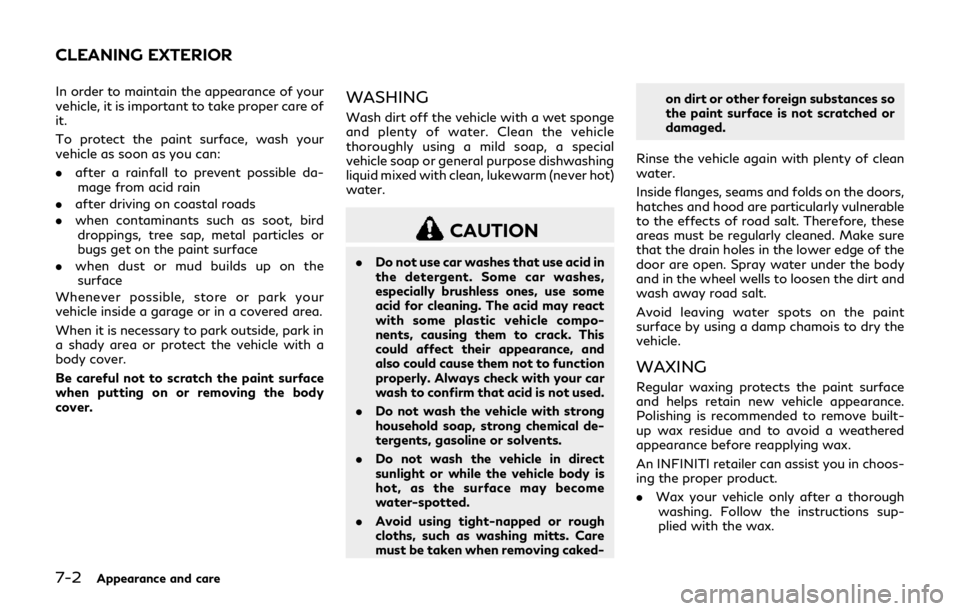
7-2Appearance and care
In order to maintain the appearance of your
vehicle, it is important to take proper care of
it.
To protect the paint surface, wash your
vehicle as soon as you can:
.after a rainfall to prevent possible da-
mage from acid rain
. after driving on coastal roads
. when contaminants such as soot, bird
droppings, tree sap, metal particles or
bugs get on the paint surface
. when dust or mud builds up on the
surface
Whenever possible, store or park your
vehicle inside a garage or in a covered area.
When it is necessary to park outside, park in
a shady area or protect the vehicle with a
body cover.
Be careful not to scratch the paint surface
when putting on or removing the body
cover.WASHING
Wash dirt off the vehicle with a wet sponge
and plenty of water. Clean the vehicle
thoroughly using a mild soap, a special
vehicle soap or general purpose dishwashing
liquid mixed with clean, lukewarm (never hot)
water.
CAUTION
. Do not use car washes that use acid in
the detergent. Some car washes,
especially brushless ones, use some
acid for cleaning. The acid may react
with some plastic vehicle compo-
nents, causing them to crack. This
could affect their appearance, and
also could cause them not to function
properly. Always check with your car
wash to confirm that acid is not used.
. Do not wash the vehicle with strong
household soap, strong chemical de-
tergents, gasoline or solvents.
. Do not wash the vehicle in direct
sunlight or while the vehicle body is
hot, as the surface may become
water-spotted.
. Avoid using tight-napped or rough
cloths, such as washing mitts. Care
must be taken when removing caked- on dirt or other foreign substances so
the paint surface is not scratched or
damaged.
Rinse the vehicle again with plenty of clean
water.
Inside flanges, seams and folds on the doors,
hatches and hood are particularly vulnerable
to the effects of road salt. Therefore, these
areas must be regularly cleaned. Make sure
that the drain holes in the lower edge of the
door are open. Spray water under the body
and in the wheel wells to loosen the dirt and
wash away road salt.
Avoid leaving water spots on the paint
surface by using a damp chamois to dry the
vehicle.
WAXING
Regular waxing protects the paint surface
and helps retain new vehicle appearance.
Polishing is recommended to remove built-
up wax residue and to avoid a weathered
appearance before reapplying wax.
An INFINITI retailer can assist you in choos-
ing the proper product.
. Wax your vehicle only after a thorough
washing. Follow the instructions sup-
plied with the wax.
CLEANING EXTERIOR
Page 368 of 458
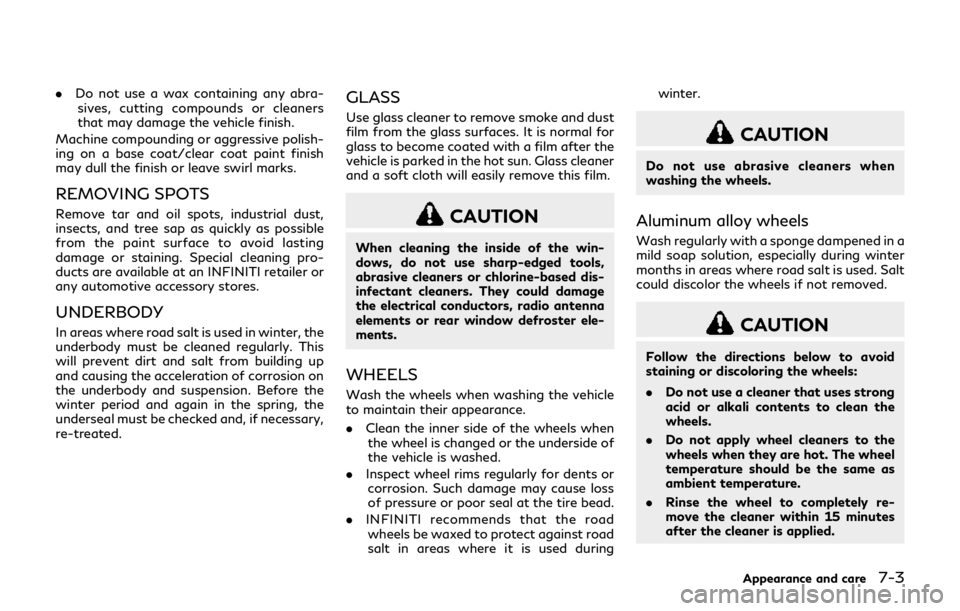
.Do not use a wax containing any abra-
sives, cutting compounds or cleaners
that may damage the vehicle finish.
Machine compounding or aggressive polish-
ing on a base coat/clear coat paint finish
may dull the finish or leave swirl marks.
REMOVING SPOTS
Remove tar and oil spots, industrial dust,
insects, and tree sap as quickly as possible
from the paint surface to avoid lasting
damage or staining. Special cleaning pro-
ducts are available at an INFINITI retailer or
any automotive accessory stores.
UNDERBODY
In areas where road salt is used in winter, the
underbody must be cleaned regularly. This
will prevent dirt and salt from building up
and causing the acceleration of corrosion on
the underbody and suspension. Before the
winter period and again in the spring, the
underseal must be checked and, if necessary,
re-treated.
GLASS
Use glass cleaner to remove smoke and dust
film from the glass surfaces. It is normal for
glass to become coated with a film after the
vehicle is parked in the hot sun. Glass cleaner
and a soft cloth will easily remove this film.
CAUTION
When cleaning the inside of the win-
dows, do not use sharp-edged tools,
abrasive cleaners or chlorine-based dis-
infectant cleaners. They could damage
the electrical conductors, radio antenna
elements or rear window defroster ele-
ments.
WHEELS
Wash the wheels when washing the vehicle
to maintain their appearance.
. Clean the inner side of the wheels when
the wheel is changed or the underside of
the vehicle is washed.
. Inspect wheel rims regularly for dents or
corrosion. Such damage may cause loss
of pressure or poor seal at the tire bead.
. INFINITI recommends that the road
wheels be waxed to protect against road
salt in areas where it is used during winter.
CAUTION
Do not use abrasive cleaners when
washing the wheels.
Aluminum alloy wheels
Wash regularly with a sponge dampened in a
mild soap solution, especially during winter
months in areas where road salt is used. Salt
could discolor the wheels if not removed.
CAUTION
Follow the directions below to avoid
staining or discoloring the wheels:
.
Do not use a cleaner that uses strong
acid or alkali contents to clean the
wheels.
. Do not apply wheel cleaners to the
wheels when they are hot. The wheel
temperature should be the same as
ambient temperature.
. Rinse the wheel to completely re-
move the cleaner within 15 minutes
after the cleaner is applied.
Appearance and care7-3
Page 369 of 458

7-4Appearance and care
CHROME PARTS
Clean chrome parts regularly with a non-
abrasive chrome polish to maintain the
finish.
TIRE DRESSING
INFINITI does not recommend the use of tire
dressings. Tire manufacturers apply a coat-
ing to the tires to help reduce discoloration
of the rubber. If a tire dressing is applied to
the tires, it may react with the coating and
form a compound. This compound may come
off the tire while driving and stain the vehicle
paint.
If you choose to use a tire dressing, take the
following precautions:
.Use a water-based tire dressing. The
coating on the tire dissolves more easily
with an oil-based tire dressing.
. Apply a light coat of tire dressing to help
prevent it from entering the tire tread/
grooves (where it would be difficult to
remove).
. Wipe off excess tire dressing using a dry
towel. Make sure the tire dressing is
completely removed from the tire tread/
grooves.
. Allow the tire dressing to dry as recom-
mended by tire dressing manufacturer.
Occasionally remove loose dust from the
interior trim, plastic parts and seats using a
vacuum cleaner or soft bristled brush. Wipe
the vinyl and leather surfaces with a clean,
soft cloth dampened in mild soap solution,
then wipe clean with a dry soft cloth.
Regular care and cleaning is required in order
to maintain the appearance of the leather.
Before using any fabric protector, read the
manufacturer’s recommendations. Some
fabric protectors contain chemicals that
may stain or bleach the seat material.
Use a cloth dampened only with water, to
clean the meter and gauge lens.
WARNING
Do not use water or acidic cleaners (hot
steam cleaners) on the seat. This can
damage the seat or occupant classifica-
tion sensors. This can also affect the
operation of the air bag system and
result in serious personal injury.
CAUTION
. Never use benzine, thinner, or any
similar material. .
For cleaning, use a soft cloth, dam-
pened with water. Never use a rough
cloth, alcohol, benzine, thinner or any
kind of solvent or paper towel with a
chemical cleaning agent. They will
scratch or cause discoloration to the
lens.
. Do not spray any liquid such as water
on the meter lens. Spraying liquid
may cause the system to malfunction.
. Small dirt particles can be abrasive
and damaging to the leather surfaces
and should be removed promptly. Do
not use saddle soap, car waxes,
polishes, oils, cleaning fluids, sol-
vents, detergents or ammonia-based
cleaners as they may damage the
leather’s natural finish.
. Do not clean the interior or trunk
using water. If water contacts the
Lithium-ion (Li-ion) battery, it may
cause a short circuit and damage the
battery.
. Only use fabric protectors approved
by INFINITI.
. Do not use glass or plastic cleaner on
meter or gauge lens covers. It may
damage the lens cover.
CLEANING INTERIOR
Page 370 of 458
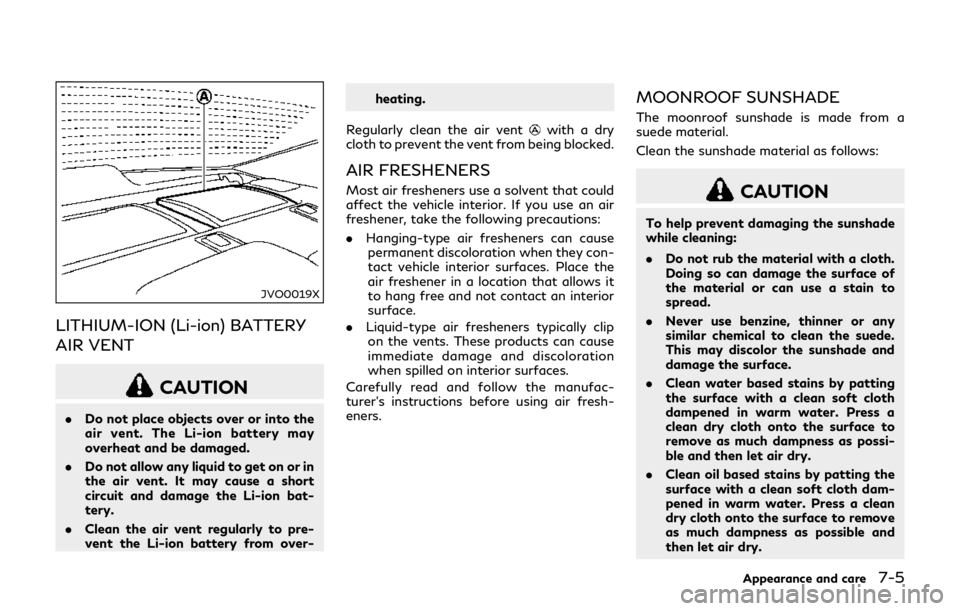
JVO0019X
LITHIUM-ION (Li-ion) BATTERY
AIR VENT
CAUTION
.Do not place objects over or into the
air vent. The Li-ion battery may
overheat and be damaged.
. Do not allow any liquid to get on or in
the air vent. It may cause a short
circuit and damage the Li-ion bat-
tery.
. Clean the air vent regularly to pre-
vent the Li-ion battery from over- heating.
Regularly clean the air vent
with a dry
cloth to prevent the vent from being blocked.
AIR FRESHENERS
Most air fresheners use a solvent that could
affect the vehicle interior. If you use an air
freshener, take the following precautions:
. Hanging-type air fresheners can cause
permanent discoloration when they con-
tact vehicle interior surfaces. Place the
air freshener in a location that allows it
to hang free and not contact an interior
surface.
. Liquid-type air fresheners typically clip
on the vents. These products can cause
immediate damage and discoloration
when spilled on interior surfaces.
Carefully read and follow the manufac-
turer’s instructions before using air fresh-
eners.
MOONROOF SUNSHADE
The moonroof sunshade is made from a
suede material.
Clean the sunshade material as follows:
CAUTION
To help prevent damaging the sunshade
while cleaning:
. Do not rub the material with a cloth.
Doing so can damage the surface of
the material or can use a stain to
spread.
. Never use benzine, thinner or any
similar chemical to clean the suede.
This may discolor the sunshade and
damage the surface.
. Clean water based stains by patting
the surface with a clean soft cloth
dampened in warm water. Press a
clean dry cloth onto the surface to
remove as much dampness as possi-
ble and then let air dry.
. Clean oil based stains by patting the
surface with a clean soft cloth dam-
pened in warm water. Press a clean
dry cloth onto the surface to remove
as much dampness as possible and
then let air dry.
Appearance and care7-5